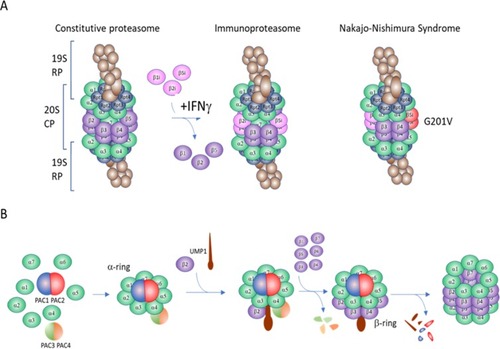Figures & data
Table 1 Frequency of clinical characteristics in Nakajo–Nishimura syndrome
Figure 1 Illustration of proteasome structure and assembly.
Notes: (A) Proteasome is formed by the assembly of a 20S core particle (CP) and two 19S regulatory particles (RP), and is called 26S constitutive or standard proteasome. 20S CP consists of two α-rings (light green) and β-rings (purple); each α-ring has seven subunits (α1-7) and each β-ring seven subunits (β1-7). When the cells are stimulated with IFNγ, β1i, β2i, and β5i are incorporated into the β-rings by replacing β1, β2, and β5, which forms immunoproteasome. G201V mutation in β5i subunit leads to proteasome dysfunction, causing Nakajo–Nishimura syndrome. (B) Assembly of 20S proteasome. Proteasome assembling chaperone 1 (PAC1)–PAC2 heterodimers and PAC3–PAC4 heterodimers assist α-ring formation. Ubiquitin-mediated proteolysis 1 (UMP1) assists β-ring formation sequentially from β2 subunit, and during and after assembly of all the other β subunits, all the PACs and UMP1 chaperones degrade and active 20S proteasome CP is formed.

Box 1 Diagnostic criteria of Nakajo–Nishimura Syndrome (NNS)
Table 2 Comparison of clinical characteristics among three PSMB8-related diseases
